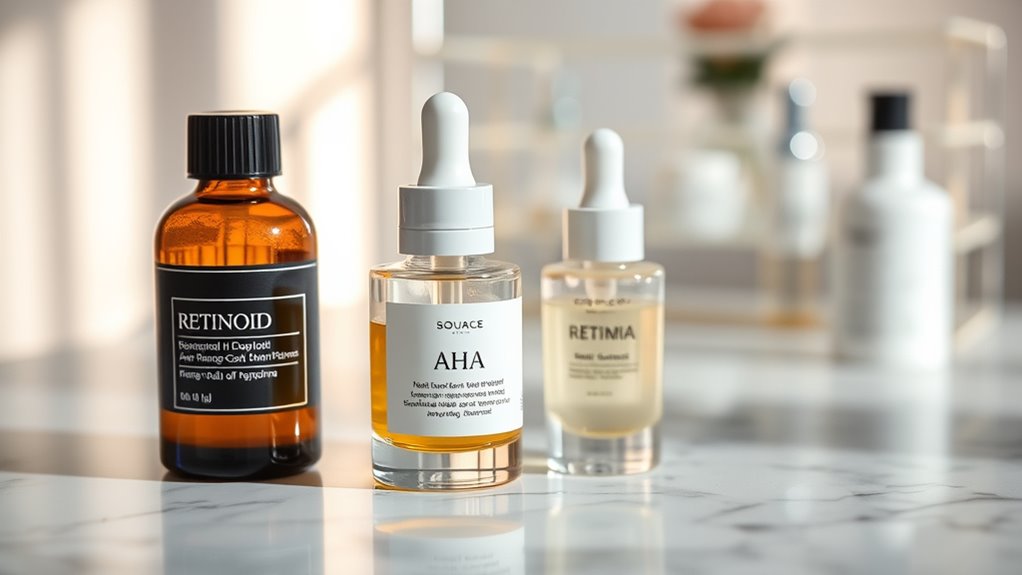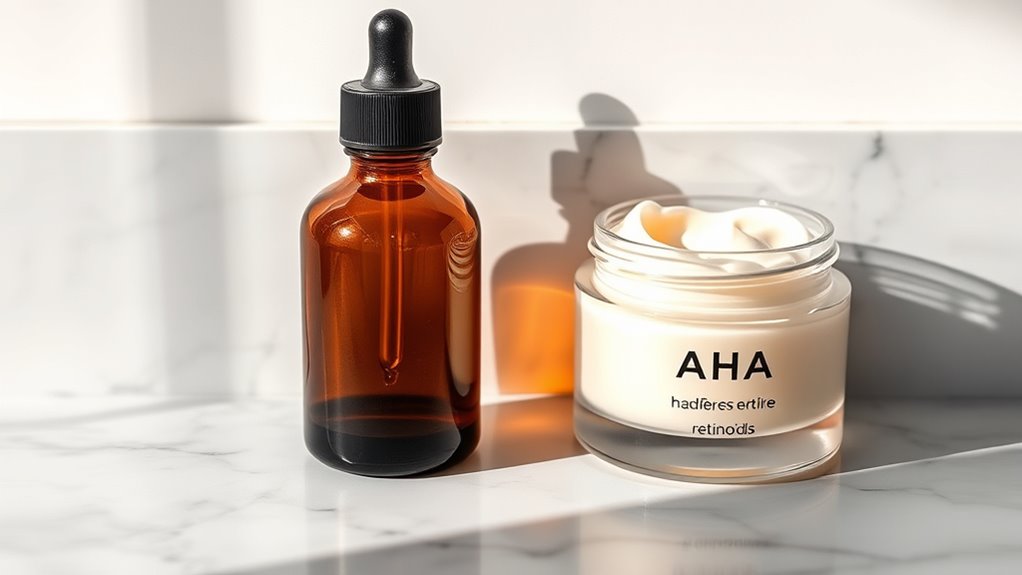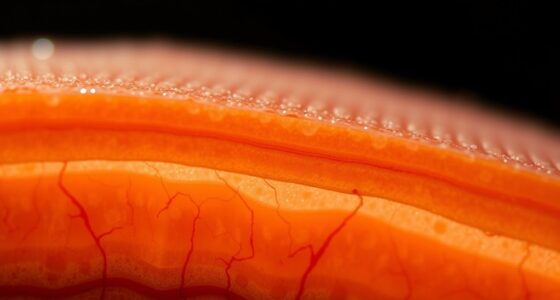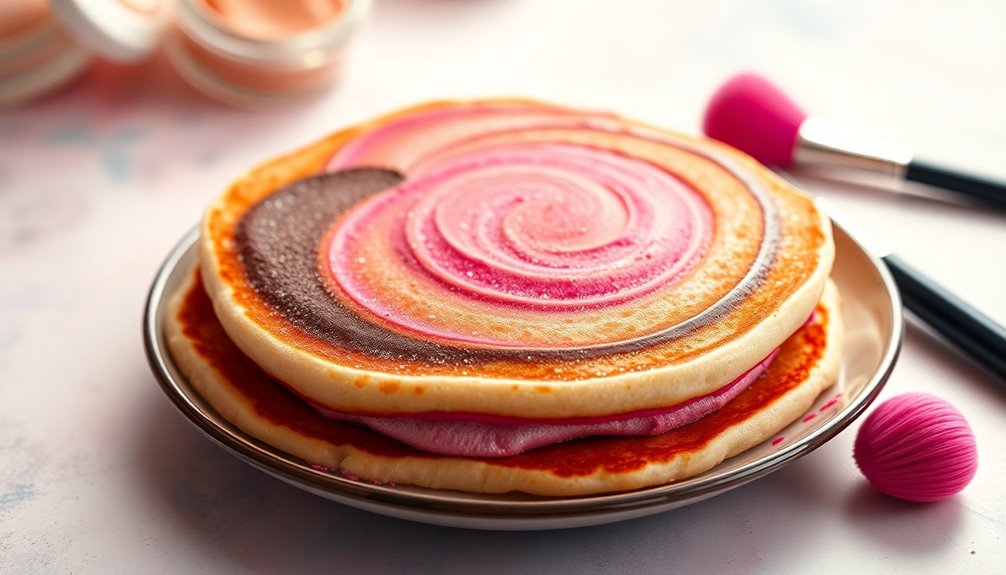Use retinoids at night to boost cell turnover and collagen without sun exposure, reducing signs of aging and acne. AHAs can be used in the morning or evening to exfoliate dead skin cells, improve texture, and brighten your complexion—just remember to apply sunscreen daily. To avoid irritation, start slow and space out their use, especially if your skin is sensitive. Keep exploring to learn how to incorporate both for the best results.
Key Takeaways
- Use retinoids in your evening routine to boost collagen and cell turnover, especially for aging or acne-prone skin.
- Apply AHAs in the morning or evening to gently exfoliate surface dead skin cells and improve texture.
- Start with retinoids gradually to minimize irritation; introduce AHAs carefully if you have sensitive skin.
- Always follow AHA use with sunscreen during the day to protect against UV damage.
- Avoid using retinoids and AHAs simultaneously; space their application to reduce irritation risk.

When choosing between retinoids and AHAs for your skincare routine, understanding their differences is essential. Both ingredients target skin concerns like aging, dullness, and uneven texture, but they work through different mechanisms and suit different skin types. Knowing which one to incorporate—and when—can make a significant difference in your results.
Retinoids are vitamin A derivatives that promote cell turnover and boost collagen production. They’re particularly effective for reducing fine lines, wrinkles, and hyperpigmentation. However, ingredient compatibility is vital; retinoids can cause irritation, especially if you have sensitive or compromised skin. If your skin tends to react strongly to actives or is dry, you might need to start with a lower concentration or use them less frequently. Skin type considerations matter here—oily and acne-prone skin often benefit from retinoids because they help unclog pores and reduce breakouts. On the other hand, if you have dry or sensitive skin, retinoids might cause dryness or redness initially, so it’s important to introduce them gradually and always follow up with a good moisturizer.
Retinoids boost cell turnover but may cause irritation; start slowly if you have sensitive or dry skin.
AHAs, or alpha hydroxy acids, are chemical exfoliants that dissolve dead skin cells on the surface, revealing fresher, smoother skin. They’re excellent for improving skin texture, reducing dullness, and addressing hyperpigmentation. When considering ingredient compatibility, AHAs tend to be gentler for many skin types but can still cause irritation if overused or if your skin is sensitive. If you have sensitive or rosacean skin, you should choose milder formulations and patch-test before applying widely. AHAs work well for normal to oily skin types, especially if you’re dealing with surface-level concerns like uneven tone or rough patches. They can also improve the effectiveness of other ingredients, like antioxidants, making them a versatile addition to many routines.
Deciding when to use each depends on your skin’s needs and responses. Retinoids are best used in your evening routine, as they increase photosensitivity and can cause sun irritation. AHAs are often incorporated into your routine in the evening or morning, but in the morning, always follow with broad-spectrum sunscreen—since exfoliation increases UV vulnerability. If you’re new to either ingredient, start slowly, using them on alternate nights or every few days, then gradually increase frequency as your skin adapts. Combining retinoids and AHAs requires caution because both can cause irritation; if you want to use both, consider applying them at different times or on different days, and always prioritize hydration and sun protection. Ultimately, understanding your skin type considerations and ingredient compatibility helps you create a safe, effective routine tailored to your skin’s unique needs.
Frequently Asked Questions
Can Retinoids and AHAS Be Used Together Safely?
Yes, you can use retinoids and AHAs together safely, but you should proceed with caution. Incorporate them gradually into your combination skincare routine and pay attention to how your skin reacts. It’s best to layer these products carefully, applying them on different nights or times of day to minimize irritation. Always use sunscreen and start with lower concentrations to prevent over-exfoliation and irritation.
Which Is Better for Sensitive Skin: Retinoids or AHAS?
Think of your skin as a delicate garden. Gentle formulations are your watering cans, nurturing without overwhelming. For sensitive skin, AHAs act like soft rain—mild exfoliation that brightens without irritation. Retinoids, however, are like a strong sun—powerful but potentially harsh. Stick with gentle AHAs to protect your skin sensitivity, helping your skin thrive without the risk of over-exfoliation or redness.
How Long Does It Take to See Results From Each?
You can expect to see visible improvements in your skin within 4 to 6 weeks of consistent use, but timing expectations vary. Retinoids often take about 8 to 12 weeks for noticeable results, especially in reducing fine lines and improving texture. AHAs typically show initial improvements in tone and brightness after 2 to 4 weeks. Patience and regular application are key to achieving the best results with either skincare ingredient.
Are There Age Restrictions for Using Retinoids or AHAS?
You can generally start using retinoids and AHAs in your teenage skincare routine, but age considerations are important. If you’re under 18, it’s best to consult a dermatologist before incorporating retinoids, as they can be strong. AHAs are usually gentler and suitable for teens with acne or uneven skin. Always patch-test new products and follow recommended guidelines to avoid irritation or adverse effects.
Can These Treatments Cause Photosensitivity or Sun Damage?
Yes, both retinoids and AHAs can cause photosensitivity, increasing your risk of sun damage. When you use these treatments, you should protect your skin by applying broad-spectrum sunscreen daily, wearing protective clothing, and avoiding excessive sun exposure, especially during peak hours. Taking these precautions helps prevent irritation and long-term damage, ensuring your skin benefits from the treatments without unnecessary risks from sun exposure.
Conclusion
Think of retinoids and AHAs as your skincare compass—each guiding you through different terrain. When you want to navigate deep, stubborn issues like wrinkles and uneven tone, retinoids are your sturdy map. For gentle exfoliation and a new beginning, AHAs are like a revitalizing breeze. Knowing when to use each lets you chart a course toward radiant skin, turning your routine into a voyage of transformation. Trust the journey; your glow awaits at every turn.










